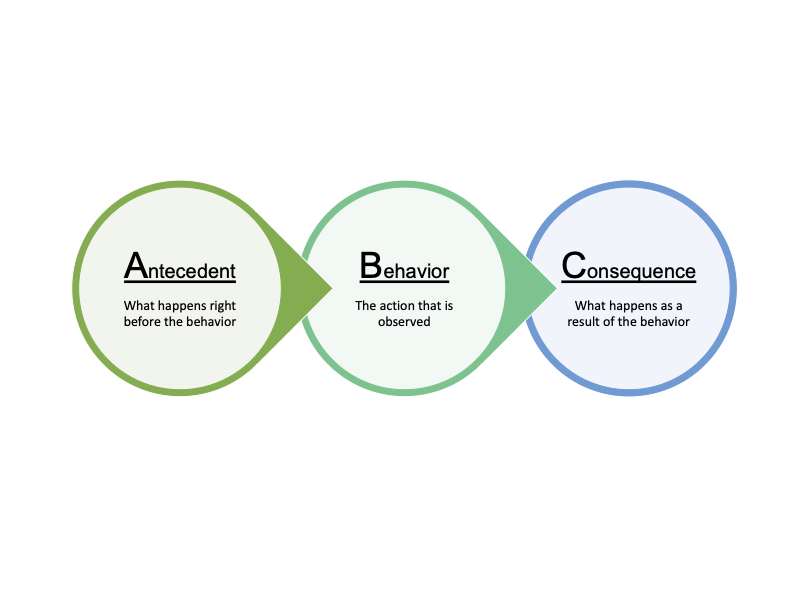ABA 101: Positive Reinforcement
The mission of Behavior TLC’s ABA 101:
To relay behavior analytic information to parents, teachers, and non-behavioral professionals through fun, engaging, and easy-to-understand content. We believe that the science of ABA and aim to make behavioral knowledge more accessible to our community.
Key Terms:
Positive reinforcement, reinforcer, antecedent, consequence, behavior, ABC Model (3-term contingency), immediacy, size, deprivation, contingency
A Tool for Behavior Change: Positive Reinforcement
The principle of positive reinforcement is undoubtedly the foundation of ethical and effective behavior-analytic practice.
In fact, it is the most widely applied principle of behavior (Cooper, Heron, & Heward, 2007). Largely based on the laboratory work of American psychologist and behaviorist, B.F. Skinner, positive reinforcement-based strategies are central to effective behavior change in clinical treatment and education. But what exactly does positive reinforcement entail? What does it mean, and how can a parent, teacher, or other helping professional use this principle in their own lives? By the end of this ABA 101 article, not only will you have a better understanding of this fundamental behavioral concept, but you will also be ready to start applying it to your own life and interactions with others.
The Meaning of Positive Reinforcement
The concept of positive reinforcement is powerful and relatively straightforward. Positive reinforcement refers to the presentation of a stimulus (i.e., a consequence, a reinforcer), contingent on behavior (meaning the behavior directly resulted in the consequence), that increases the probability of the behavior reoccurring in the future under similar conditions.
Confused? Don’t worry! Let’s break this concept down a bit more.
Reinforcers: What Are They?
Reinforcers refer to tangible objects or events that are delivered following the occurrence of behavior and increase the probability that the behavior will reoccur under similar conditions (remember that underlined part, it’s an important detail we will get back to). Picture an elementary school teacher who just began a lesson on simple addition. She asks her class to solve for 5+2 and raise their hand once they think they have the right answer. Her student, Sally, raises her hand and is called upon. Sally tells her teacher, “The answer is 7!” and her teacher responds, “Great job! You’re right!”
In this situation, we are interested in Sally’s behavior and her teacher’s response. Sally’s hand raising and verbal statement that “The answer is 7,” evoked praise from her teacher (“Great job, You’re right!”). Because we know from research that social praise is highly effective at increasing behavior, especially in children, we would expect that when Sally is later asked to solve “5+2” and raise her hand with the answer, she would be more likely to engage in hand-raising and respond that the answer is 7.
Recall that a requirement for a stimulus to be considered a reinforcer is that it must increase the probability that the behavior will occur again in the future under similar conditions. Let’s consider what might have happened if instead of receiving praise from her teacher for her correct answer, Sally received some Skittles (a candy she REALLY hates) and no verbal praise. Should we expect that this consequence (i.e., being given black licorice without praise) will cause Sally to raise her hand and answer correctly in the future when asked to solve 5+2? Absolutely not. In fact, Sally may instead decide that raising her hand and providing the answer is not worth the trouble, since all she’ll get from her teacher is some nasty candy. The point here is that simply because we think something may be reinforcing, it doesn’t mean it will be. In other words, “rewards” are not always reinforcers.
Some reinforcers are also more effective than others, and this effect can vary depending on the demand being placed (e.g., a piece of Mary’s favorite candy might motivate her to answer math problems, but it won’t even begin to convince her to write sentences) and other environmental conditions affecting the learner. When our goal is to teach new skills or to replace problem behavior with more acceptable behaviors, it is crucial that we understand the preferences of our learners and ultimately what motivates them. We need to know what they dislike, what they like, and what they absolutely love. In ABA 101, we use assessments to help us narrow down on these preferences, as well as caregiver reports on what their child likes to guide us.
Effective Reinforcement and “the A-B-C Model”
Lastly, it is important to understand that the characteristics of a reinforcer influence how effective it is at increasing desirable behavior. The immediacy of reinforcement, for example, is crucial to helping the learner understand why exactly they are receiving the reinforcer. By delivering the reinforcing consequence soon after the learner shows us something we want to see more of (such as asking us for help, tying their shoe by themselves, or sharing nicely with a friend), we can help to make this behavior contingency more apparent: If ______ happens, and I do ______, I will get ______, and I enjoy that! In ABA 101, we describe this in a model known as the 3-term contingency or the ABC model.
Our “ABCs” help us to understand the events that evoke and sustain behavior:

The antecedent refers to an event that “sets the stage” for the behavior to occur and happens right before the behavior of interest is observed. In our earlier example, Sally’s teacher’s instructions to “Solve 5+2 and raise your hand when you have the answer” is an example of an antecedent. The behavior, of course, refers to the action(s) a person does. Sally’s hand-raising and verbal response that “The answer is 7,” are her observable behaviors. Lastly, the consequence of a behavior is what occurs because of the behavior. Sally received praise from her teacher because of her hand-raising and correct response. Remember, in the context of positive reinforcement, the consequence of the behavior increases the probability of the behavior reoccurring in similar conditions.
Through the ABC model, it makes sense why immediacy of reinforcement is so vital to increasing behavior, but what are some other characteristics of effective reinforcers?
These characteristics include:
- Size or the reinforcer amount is an inappropriate relationship with the number of tasks and/or task difficulty
- Quality, where the reinforcer is highly preferred by the learner
- Deprivation, where the learner has limited access to the reinforcer
- Contingency, where the reinforcer is delivered only when desirable behavior occurs
By providing a learner with a reinforcer that embodies these criteria, we can rest assured that our chosen stimulus (e.g., praise, an edible, or a tangible) will truly function as a reinforcer and we increase the behavior we want to see more of.
Applying Positive Reinforcement
Now that we have defined positive reinforcement within this ABA 101 post, and have discussed what makes for an effective reinforcer, you may have begun thinking of ideas on how to use this behavioral principle in your own life. Truly, the applications of positive reinforcement are endless. It is this versatility that makes positive reinforcement such a valuable intervention tool. Here are a few ideas to help jumpstart your use of positive reinforcement:
- Provide the desired item when your child verbally requests it to increase expressive language. For example, giving your child their juice when they say, “I want some juice” instead of simply pointing to the juice.
- Providing specific, positive feedback when a student does something well on an assignment, such as “Those are some amazing details in your story. Nice job!”
- Providing highly-preferred reinforcers for fulfilling behavior goals, like Xbox privileges for all-day classroom participation.
Positive reinforcement is a powerful tool for increasing behavior. By using reinforcers that are individualized to the learner’s preferences, and are immediate, high-quality, an appropriate size, limited, and contingent on desirable behavior, you yourself can promote effective and worthwhile behavior change.
ABA 101 – TEST YOUR KNOWLEDGE!
- Jimmy is learning how to tie his shoes independently. For each step of the shoe-tying process that he performs without prompts, he receives a small M&M (a highly-preferred food). Since this intervention, Jimmy has been able to tie his shoes more independently. In this scenario, what is the function of the M&M?
- punisher
- reinforcer
- reprimand
- reward
- Mary is training her dog to sit. If her dog sits after she instructs “Sit,” she gives him a small treat. Mary has noticed her dog has begun to sit in response to her command, even when she has no treats. What principle of behavior is Mary using to teach her dog to sit?
- negative reinforcement
- positive punishment
- positive reinforcement
- negative punishment
- Jennifer is teaching her student to solve a simple addition problem. Each time her student solves a problem correctly without help, she quickly responds, “Nice job! I love how you were able to solve that all by yourself!” The percentage of math problems her student is able to solve independently has increased. What characteristic of an effective reinforcer does this scenario demonstrate?
- size
- quality
- deprivation
- immediacy
Answers:
- B.
- C.
- D.
References:
Cooper, J. O., Heron, T. E., & Heward, W. L. (2019). Applied Behavior Analysis (3rd Edition). Hoboken, NJ: Pearson Education.
Want to learn more?
Check out this blog post on Bribery vs Positive Reinforcement.
Struggling with problematic behaviors? Want to learn more about ABA Therapy? Contact Behavior TLC today and let’s talk!











